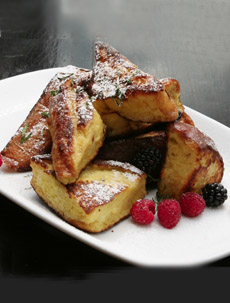Brioche French Toast Recipe With Dulce De Leche
|
Our mom didn’t have to be convinced to whip up a batch of French toast, one of her favorite weekend breakfast foods.
While she used challah, eggs and cream to rich effect, here’s an even richer recipe—a signature brunch dish at the Sushi Samba restaurants in New York City (there are other locations nationwide). If you’re in New York City for a brunch, head to Sushi Samba’s Gramercy or West Village locations. The French toast is on the $30 pre-fixe menu; bottomless Prosecco can be added for an additional $25. Everyone else: Make it yourself at home! You may notice that there’s no dulce de leche in the recipe below. That’s because dulce de leche is made by heating sweetened condensed milk until it caramelizes. Soaking the bread in sweetened condensed milk embeds the flavor of dulce de leche in it. Ingredients For 4 Servings *Sushi Samba, which has a Brazilian flair, uses the Portuguese term, doce de leite, instead of the Spanish dulce de leche. |
 [1] It doesn’t get richer than this (photo © Sushi Samba | NYC [now closed])! 
[2] A loaf of brioche (photo © King Arthur Flour ). |
|
|
Preparation 1. PLACE brioche in a 275°F oven for 5-10 minutes to dry. 2. COMBINE all the liquid ingredients and add the bread. Allow the brioche to soak for 1-2 minutes. 3. COOK on a flat top or in a nonstick sauté pan for 2 minutes per side and finish in a 350°F oven for an additional 3 minutes, or just until the center has firmed. 4. GARNISH with the fruits of your choice and powdered sugar. |
||
|
|
WHAT IS BRIOCHE
Brioche (bree-OASH) is light, slightly sweet bread made with eggs, yeast and butter, and glazed with an egg wash. Richer than a standard loaf of bread, brioche is used as a breakfast bread, for French toast and in combination with luxurious first courses such as foie gras and smoked salmon. The word brioche first appeared in print in 1404. The recipe is believed to be based on a traditional Norman recipe, a form of which may have been brought to Gaul by the Romans (but Southern Europe was not focused on dairying, hence no butter, using olive oil instead). The sweetness of the bread led it to be served as a pastry or as the basis of a dessert, with many local variations adding other ingredients, fillings and toppings [source]. Brioche is the best bread for French toast and bread pudding, and also famously served with foie gras and other meat-based terrines and mousses. The philosopher Jean-Jacques Rousseau, in his 1783 autobiography “Confessions,” writes that “a great princess” is said to have advised, regarding what to do about starving peasants, “S’ils n’ont plus de pain, qu’ils mangent de la brioche”. This is commonly translated as “If they have no bread, let them eat cake.” After publication, it was speculated that these words of compassion and noblesse oblige [not!] actually referred to Maria Theresa of Spain (1638-1683), the wife of Louis XIV (her husband’s paternal grandmother), or various other aristocrats. If so, Marie-Antoinette may have known, and repeated, the phrase, which has since been attributed to her. Either way, both aristocratic ladies, who never went without, could have used some compassion. |
|
|
|
||




